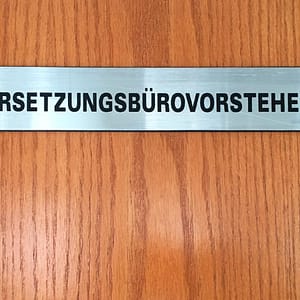Content, Culture, and Copywriting: An Introduction to Transcreation
Translation may be appropriate for instruction manuals or legal documents, but making a tagline, slogan, or ad copy resonate in another culture is not nearly as straightforward. Making an authentic connection with people living in different countries requires a different approach. Your global audiences won’t respond well to a campaign that sounds like a translation of your American campaign. Give them a message that is mindful of the cultural context and language differences, and feels as though it was created with their needs, wants, and desires in mind.
Oops
When things go wrong, they can go wrong in a big way.
American Airlines took their “Fly in leather” campaign to Mexico with the intent of targeting a new audience of first-class passengers. However, the English to Spanish translation read, “vuela en cuero,” which is Spanish for “fly naked.”
HSBC had to spend $10 million rebranding its global private banking operations after its tagline “Assume Nothing” was not effective across all markets. In a number of countries, the translation read “Do Nothing,” quite an ineffective call to action.
Volkswagen committed a slightly more complex blunder with its audiences in Brazil. The company rolled out its worldwide “Das Auto“ campaign with the objective of calling attention to the German engineering of its cars, typically considered a mark of high quality. This strategy worked well in many places, but not in Brazil where the VW Beetle had been manufactured for many years. Brazilians felt a strong relationship with the company and took pride in the role they played in the manufacturing process. Volkswagen had previously reinforced this relationship with an earlier slogan, “você conhece, você confia” (“you know, you trust”). However, when Volkswagen began using the “Das Auto” line in Brazil, they destroyed the bond many Brazilians had developed with the brand.
Translation Versus Transcreation
Translation is the process of rendering text from one language into another. The intent of the message must be conveyed in the target language (the one you translate into), and the finished translation should sound as if it was written by a native speaker of that language.
Transcreation, also known as creative translation, is about adapting ideas and concepts, not just words. It takes into consideration the cultural differences and the effectiveness of the content on the target culture. It is sometimes necessary to make substantial changes to the original content in order to adapt the message so it resonates. The result is often a combination of newly developed content, translated content, and content that has been recreated.
While a straightforward translation is typically more appropriate for content that is technical or scientific in nature, companies use transcreation when they want to fully adapt their materials for audiences in different locales. It is most commonly used for marketing and advertising communications, including websites, advertising, and creative concepts that do not always translate directly from one culture to another.
Behind the Scenes
Transcreation is a tough job. To do it right, it needs to be handled by specialists who can interpret your marketing team’s intent and grasp the emotions you are aiming to evoke. They must then be able to write language that will effectively communicate your intent while staying true to your brand. This requires multilingual copywriters who have experience writing creative copy for marketing purposes and who are also experts in the subject matter.
Linguists should be native speakers of the target language, live in the country for which the content is intended, and be fully immersed in its culture. This helps them understand first-hand the cultural differences and any other current political, social, or other issues that will impact the way your message is perceived.
For transcreation projects, a translation company will typically assemble a team that includes multiple linguists. The process begins with your creative brief. The linguists review your brief so they can fully understand the concept, campaign objectives, and the desired outcomes. For best results, this document should include a description of the target audience, style, tone, and intent.
The team will work to adapt your language so that it fulfills the objective of the original campaign and triggers the intended emotional reaction and response. They will ensure the content does not include text or images that have negative connotations in the target culture. Idioms, colloquialisms, language, humor, and slang may need to be reinvented.
Meetings between the translation company’s team and the client help ensure everyone is on the same page and the messaging being presented is true to the creative vision of the original content. While standard translation is usually charged at a per-word rate, a translation company will typically quote transcreation at an hourly fee or on a per-project basis.
Success Stories
Here are a few examples of content that has been successfully reinvented for diverse global markets:
The Spiderman comic book was redeveloped for the Indian market with a revised narrative telling the story of Pavirt Prabhakar (Peter Parker). Pavirt is a simple Indian boy from a remote village who moves to Mumbai, encounters an ancient yogi who grants him the powers of a spider and uses his powers to fight evil. The character is one that Indian readers can relate to, and the American icon was successfully reinvented. The re-envisioned narrative incorporates the racial and geographic characteristics of the culture, and Pavirt even wears an appropriate, slightly modest Spiderman costume, modeled after a dhoti, a loincloth worn by men in India.
The famous Dr. Seuss story Green Eggs and Ham is another great example, recreated for Spanish audiences as Huevos verdes con jamón. You can’t just translate Dr. Seuss from English to Spanish. The play on language, cadence, made-up words and nonsensical characters are essential to creating the magic. Sam-I-Am becomes Sam-Yo-Soy, the famous character who is set on convincing his unnamed friend to try that plate of green eggs and ham. The English to Spanish was not just translated, it was recreated so the language has its own flow and rhyme that sounds natural and captures the essence of Dr. Seuss’s playful language.
A great example of transcreation in the consumer world is Johnny Walker. In 2000, the company’s striding man logo inspired Johnny Walker’s “Keep Walking” campaign, which has since been used in over 120 markets worldwide. Read more about how this campaign was adapted for Chinese markets, successfully driving web traffic and narrowing the gap with the number one brand in the Chinese Whiskey market, Chivas Regal.
Capture Their Hearts and Minds
When you want people in different countries to have an emotional response to your message and feel a personal connection to your brand, they need to feel that your messaging was created just for them. This means paying close attention to the subtle nuances, the cultural differences, and possibly using a mix of language solutions. Depending on the nature of the content, this may require translation, transcreation, or a combination of both, provided by linguists who are experts in the content, culture, copywriting, and, of course, the language. The extra step taken to thoroughly adapt your message can trigger the response and engagement you’re looking for.
 Named to the 2023 Inc. 5000 list of fastest-growing companies and ranked among the world’s top 100 language service providers by CSA Research
Named to the 2023 Inc. 5000 list of fastest-growing companies and ranked among the world’s top 100 language service providers by CSA Research

